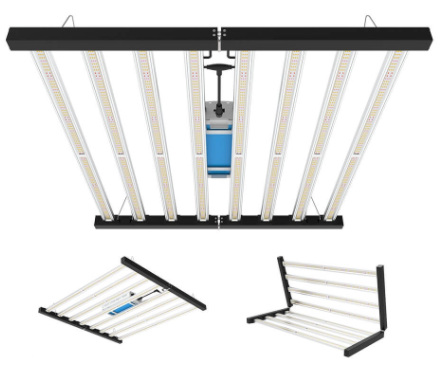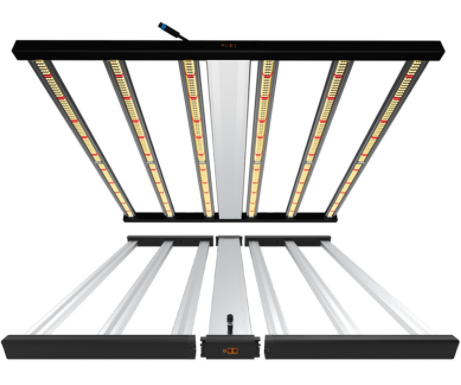What You Need to Know about LED Grow Lights
LED grow light is an artificial light source with LED (Light Emitting Diode) as the light emitting body to meet the light conditions required for plant photosynthesis. By type, it belongs to the third generation of plant supplemental light fixtures!
LED grow light is an artificial light source with LED (Light Emitting Diode) as the light emitting body to meet the light conditions required for plant photosynthesis. By type, it belongs to the third generation of plant supplemental light fixtures!
In environments where there is a lack of daylight, these lamps can act as daylight so that plants can grow and develop normally or better.
This kind of light has the function of strengthening roots, boosting growth, regulating flowering period and color, promoting fruit ripening and coloring, and enhancing taste and quality!
growth light has more environmental protection and energy saving, LED plant light to provide photosynthesis to plants, promote growth, reduce the time used for plant flowering and fruiting, improve production! In modern construction, it is indispensable for crops. LED growth lights have the following main technical points.
Color temperature and lumens of plant lights
The color temperature and lumens of a plant light are seen by the human eye, while the photosynthesis of light by plants does not depend on color temperature and lumens.
The effect of spectral range on growth
280 ~ 315nm: Minimal effect on morphology and physiological processes
315 ~ 400nm: Less chlorophyll absorption, affects photoperiodic effect, prevents stem elongation
400 ~ 520nm (blue): the largest ratio of chlorophyll to carotenoid absorption, and the greatest impact on photosynthesis
520 ~ 610nm (green): the absorption of pigments is not high
610 ~ 720nm (red): low absorption of chlorophyll, significant effect on photosynthesis and photoperiodic effect
720 ~ 1000nm: low absorption rate, stimulates cell lengthening and affects flowering and seed germination
>1000nm: converted into heat
PPF(Photosynthetic Photon Flux)
PPF (Photosynthetic Photon Flux) is the number of micromoles of photons per second, in umol/s, radiated by artificial light sources in the wavelength range of 400-700 nm. PPF values are measured both for the total value of the lamps and for the components at 100 nm intervals. This is because it is necessary to obtain both the total PPF of the luminaire and to know the components of the different wavelengths, that is, the light recipe; it can only be measured with an integrating sphere specifically designed to test grow lights.

Far-red (700-800nm) PF
The PF values for far red (700-800nm) are listed separately. This is because far red is outside the photosynthetically effective radiation range and cannot be characterized by PPF. In particular, luminaires with far-red PF greater than 5% need to calculate the PF maintenance rate for far-red for reporting purposes.
PPE (photosynthetic photon efficiency)
PPE (photosynthetic photon efficiency) greater than 1.9umol/J, with a minimum limit of 1.8umol/J. Like the luminous efficacy of lamps for lighting, the same minimum luminous efficacy is set for plant lighting.
PPF maintenance rate
PPF maintenance rate Q90 is greater than 36,000 hours. This is the life expectancy standard for plant lighting fixtures.
For luminaires using multiple wavelength LEDs, the LED manufacturer's LM80 data is required. LEDs with >25% PPF in the luminaire correspond to Q90>36000hr.
PPFD (photosynthetic photon flux density)
PPFD (Photosynthetic Photon Flux Density) corresponds to the PPF is the number of micromoles per square meter per second radiated from the light source, in umol/m2s, the concept of density.
PPFD is the PPF expressed in the range of one square meter.
PPFD is a physical quantity related to the radiation distance, inversely proportional to the square of the irradiation distance.
1PPFD indicates the number of photons radiated in 1 micromol per second over a surface of 1 square meter.
How large is 1umol/m2s (PPFD)?It indicates 6 photons in 10 square nanometers.
Relationship between PPFD and PPF: PPFD is the fundamental quantity derived from the planting process parameters and PPF is the main parameter for luminaire manufacturing.

YPFD: Yield Photon Flux Density (YieldPhotonFluxDensity)
Corresponding to YPF is the number of micromoles of radiation per square meter per second, in umol/m2s, the concept of density.
YPFD is expressed in the range of one square meter YPF.
YPFD is a physical quantity related to the radiation distance, inversely proportional to the square of the distance irradiated.
YPFD is more accurate to express the amount of light of LED plant light quality.
Today's sharing ends here. I hope this science article can help you. Besides, we are a LED grow light supplier, please feel free to contact us if you need them!